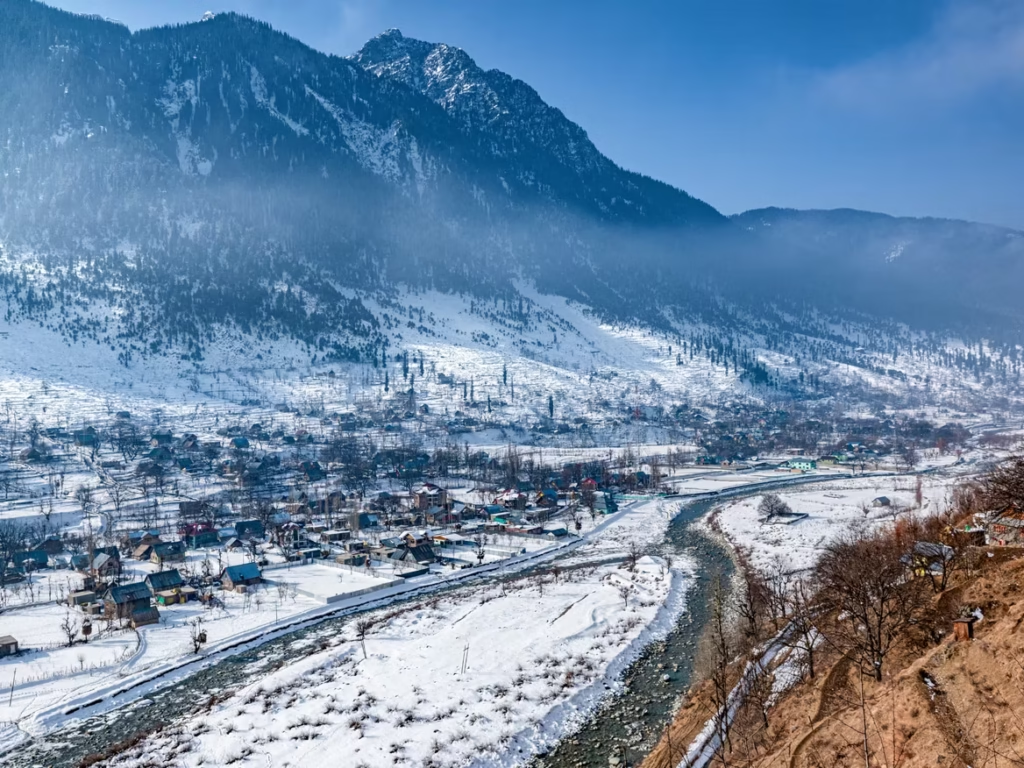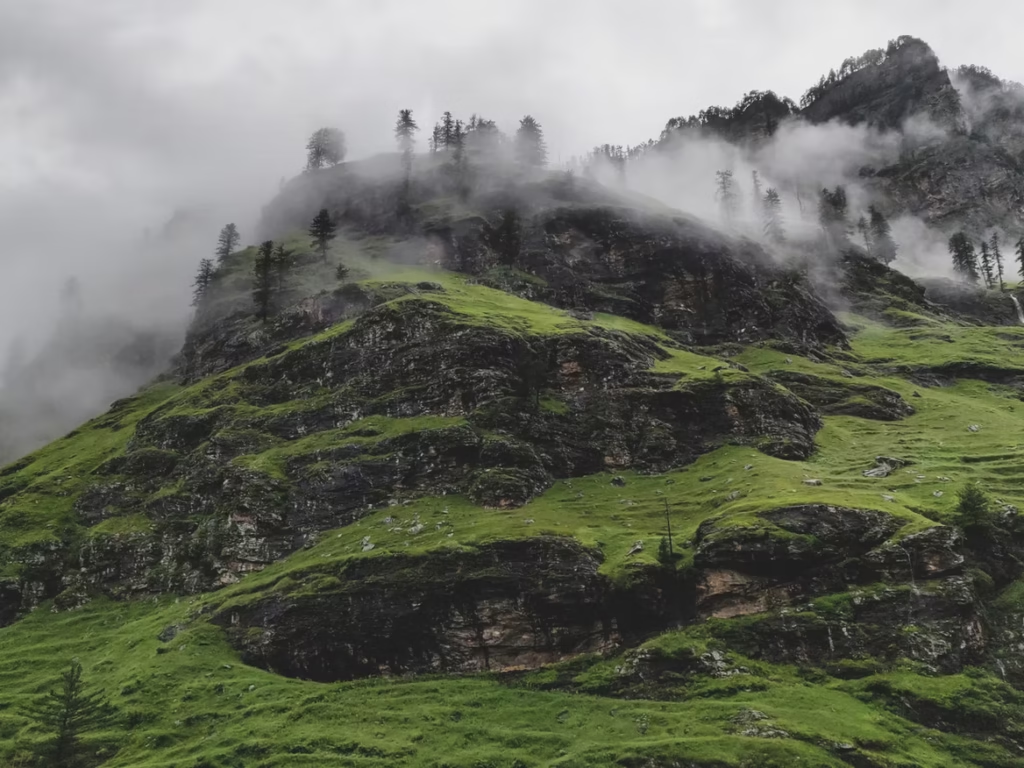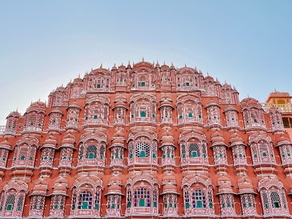The Ultimate Manali Travel Guide: How to reach and get around the mountain town.

Situated high up in the Himalayas, Manali has rightfully earned its reputation as one of India’s top tourist destinations. Framed by snow-capped peaks and boasting lush green forests, this quaint mountain town promises postcard-perfect views at every turn. From adventures like rafting and skiing to cultural treasures like ancient temples, Manali attracts travelers seeking both adrenaline rush and serenity. The laidback cafes, Tibetan monasteries, and local handicraft shopping beckon as well. Regardless of whether you seek nature’s embrace or prefer soaking in history, Manali delivers ample opportunities. Its cool and pleasant climate during summer provides welcome respite from India’s sweltering heat. Reaching this mountain gem is easy, and getting around quite hassle-free. This guide will equip you to plan an immersive trip to Manali. The astounding beauty of Manali during the Winters (Source: canva) Arriving in Manali: Journey to the Mountains Manali is well connected to the other parts of India through air, road and rail. You can reach the hill station through the following methods: By Air The nearest airport is Bhuntar Airport located around 50km from Manali in the Kullu district. It has regular flights from Delhi, Chandigarh, Shimla and other major cities by airlines like Air India, IndiGo, SpiceJet, etc. Taxis charge about ₹2000 to reach Manali from the airport. One can also take a bus which costs around ₹200 per person. By Rail The closest major railway station is Joginder Nagar railway station, approximately 165km from Manali. It falls on the Pathankot–Jogindernagar narrow gauge railway line. The train route is incredibly scenic but takes around 10 hours from Pathankot. From Joginder Nagar you can hire a taxi or take a Himachal Road Transport Corporation (HRTC) bus to cover the 6 hour onward journey to Manali. By Road The most popular way to get to Manali is by road. National Highway 21 connects Manali to Chandigarh and further to other major cities. The highway is well maintained with scenic views throughout. Luxury Volvo buses by HRTC provide a comfortable overnight journey from Delhi, taking about 14 hours. You can also hire a private taxi or self-drive your own car on this route. Zigzag roads win you over with mountain vistas. Stopovers in towns like Karnal and Bilaspur can break the trip. If you want to plan a road trip from Delhi-Manali, read this blog. Train taking a sharp turn on a mountainous bridge (Source: canva) Day Trips from Manali: Nearby Gems to Explore With its location in the hills, Manali serves as an ideal base to explore scenic destinations nearby. Some recommended day trips are: Rohtang Pass Located 51 km from Manali, the high mountain pass of Rohtang lies at an altitude of 3978 m. Visit to see snow even in summers and gorgeous views. Requires permit. Solang Valley Just 13 km from Manali, Solang is renowned for adventure sports like paragliding, zorbing and skiing. During summer you can hike here or picnic by the river. Naggar Village This quaint village 20 km from Manali has European style castle, temples, museums and art galleries to explore on a day trip. Manikaran The religous town of Manikaran located 45 km from Manali attracts pilgrims to its hot springs and beautiful Sikh gurudwara. With so much natural beauty around, taking day trips from Manali allows you to make the most of your time there. Follow the tips above for memorable short excursions. Morning View of Manikaran across the shore (Source: canva) Manali awaits! With its idyllic setting amidst snow-clad mountains and spiritual aura, Manali casts a spell on all who visit. Reaching this Himachal town is easy by air, road and rail. Navigating within Manali can be done conveniently by buses, rental vehicles, bicycles or on foot. The destinations near Manali like Rohtang Pass and Solang Valley promise adventure and stunning vistas. Take scenic day trips and partake in activities like paragliding for once-in-a-lifetime experiences. From ancient temples to gushing rivers, Manali is a gateway to some of India’s most prized natural wonders. You can also check out this free AI planner travel to better plan your trips as per you desirable preferences and budget constraints. Free AI Travel Planner
Planning a Trip to Manali this Summer? Here’s What You Need to Know About the Weather

Nestled high up in the magnificent Himalayan mountains of Himachal Pradesh, Manali stands as one of India’s most idyllic and popular summer retreats. As the sweltering summer months approach, you may be dreaming of planning a rejuvenating escape to this picturesque hill station, away from the scorching heat of the plains. However, before packing your bags with gusto, it is essential to understand Manali’s fickle climate and weather patterns during the summer. The weather in Manali can fluctuate wildly and be extremely unpredictable in the summer months between May to August. Sudden downpours, chilling thunderstorms, misty clouds obscuring mountain views – the weather vagaries are manifold. View of a foggy mountain peak (Source: canva) Thus, advance planning and preparation becomes critical to truly enjoy the summer charms of Manali despite the temperamental climes. In this blog, I will provide a detailed overview of Manali’s weather and climatic conditions. You will get insights into the temperature range, humidity levels, frequency of rainfall, sunny intervals, and the impact of altitude on weather during this season. Additionally, I will share how the weather affects key summer activities like sightseeing, trekking, adventure sports, and transportation around Manali. By understanding all these facets, you can pack smartly, plan your summer holiday efficiently and make the most of your time in Manali irrespective of the weather gods’ whims! Manali’s weather: Quick glance Weather in Manali across the year (Source: cottagesinmanali) Summer (April – June) Summers see pleasant daytime temperatures in the range of 15°C to 25°C. However, humidity levels start rising to 65-70% by May end indicating the onset of monsoon. Rainfall also increases from June with occasional heavy downpours. Monsoon (July – September) The monsoon months are humid with average humidity levels spiking to 75-80%. Persistent heavy rainfall occurs with a monthly average of 350mm during peak monsoon season. Temperatures are cooler in the range of 12°C to 20°C.] Winter (December – February) Winters are dry and cold with negligible rainfall. Humidity levels drop further to 40-50%. Temperatures plummet below freezing point after sunset to -5°C with highs of about 10°C during the day. Spring (March – April) The spring months of March and April see temperatures rising to pleasant highs of 18°C to 25°C though nights can still be cool in Manali, with moderate rainfall occurring as light showers during this pre-monsoon transition period. However, sudden weather changes including snowfall at higher altitudes are common as the region moves from winter chill to summer warmth. Best time to visit Manali A camping site full of tourists (Source: canva) Now arrives the most awaited question- What is the best time to visit Manali? However, the answer is that it completely depends on your personal preferences. Here is a list of the pros and cons of visiting Manali in each of the seasons-: Summer (April – June) Pros: Warm, sunny days perfect for sightseeing and photography Can participate in adventure activities like paragliding, camping Scenic mountain views before monsoon fog sets in Fewer tourists and cheaper prices before mid-May Cons: Unexpected heavy showers start by late June with monsoon Rohtang Pass closed due to snow clearance Monsoon (July – September) Pros: Lush green valleys and fores with beautiful views Discounted rates ideal for budget travellers Great for white water rafting with raging rivers Less crowded compared to peak summer Cons: Heavy persistent rainfall leads to landslides Frequent disruption of travel due to landslides and road blockages High chances of road closures especially to Rohtang Pass Limited views due to fog and cloud cover Winter (December – February) Pros: Snow-covered landscapes look picture perfect Activities like skiing, snowboarding, snowmobiling Discounted hotel rates and fewer tourists Hot springs and spas ideal in cold weather Cons: Extremely cold temperatures ranging from -5°C to 10°C Heavy snowfall can block roads and led to being stranded Limited connectivity and accessibility due to road closures Most activities closed down during peak winter Spring (March – April) Pros: Pleasant weather with temperatures rising up to 25°C Lush valleys and flowering fruit orchards Off-season discounts on stays continue Religious festivals like Holi and Easter Cons: Sudden snowfall on higher altitudes still possible Some tourist spots remain closed before peak summer High chances of rain during March Visiting Manali in each season arrives with their own set of pros and cons. Even though some of the pros may overweigh others, visiting the hill station in every season comes out as a completely different experience. What to pack for your Manali trip? A snowy landscape in Manali (Source: Unsplash) Here are some packing recommendations for Manali for each of the four seasons round the year-: Summer (April-June) Summers in Manali have pleasant daytime temperatures, but the high altitude can lead to sun exposure. Cotton clothes that are light and airy suit the generally hot climate. Hats, sunglasses and sunscreen become essential to protect against UV rays at high altitudes. The evenings can get breezy and cooler, so carrying light jackets is advised. For outdoor activities like hiking, sturdy trekking shoes with a good grip are a must. By mid-June, monsoon showers begin, so packing umbrellas becomes vital for protection. Monsoon (July-September) The monsoon months witness heavy downpours in Manali. Rain jackets and umbrellas are a must to stay dry during the persistent showers. With trails becoming slippery, sturdy waterproof boots help maintain stability and prevent falls. Quick dry clothes that can wick moisture are recommended to handle humidity and sudden downpours during outdoor excursions. Leech socks offer protection from leeches prevalent during hikes in the rainy season. Carrying medicines for common ailments like allergies, cold and body aches provides comfort in the damp weather. Winter (December-February) The cold dry winters of Manali call for ample warm clothing. Heavy woolens including sweaters, thermals and jackets help insulate the body from the chilling cold. Snow boots with good traction and gaiters are
7 Days in Rajasthan: A Perfect Itinerary for Exploring the Land of Maharajas

Welcome to the enchanting land of Rajasthan, where history, culture, and grandeur blend seamlessly to create an unforgettable travel experience. Known as the “Land of Maharajas,” Rajasthan is a vibrant state in India that boasts magnificent palaces, majestic forts, and a rich heritage that dates back centuries. A visit to Rajasthan is like stepping into a fairy tale, where every corner exudes regal splendor and tales of valor. Without a doubt, Rajasthan attracts a sizable number of tourists due to its vibrant cities. Men enjoy the colourful turbans that ladies wear, and even the names of the cities Jaipur (Pink City), Udaipur (White City), and Jodhpur (Blue City) have colours linked with them. The most renowned annual camel market in Pushkar, which takes place in the months of October to November, is the best place to view all these colours in action. In its territory count the most beautiful attractions of India with its impenetrable forts, the magnificent havelis, as well as a richness of cut and traditions that have no equal. With so many reasons to visit, is it any question that this place serves as the perfect destination to introduce your kids to the wonderfully rich past of their country? A Rajasthan itinerary is an ideal way to bond with your loved ones and have a memorable time. It is advised that you schedule your trip to Rajasthan during the winter months if you want to visit the most picturesque locations there. It would be best to schedule your trip for the months of November through February. Extreme summer and winter temperatures are typical in Rajasthan. Planning a trip to Rajasthan can be overwhelming due to the plethora of attractions and cities it offers. Literally any city can be considered as the starting point of your Rajasthan trip. However, we’ve given you an ideal travel plan to follow in this travel guide to Rajasthan. To help you make the most of your time, we have crafted a perfect 7-day itinerary that will take you through the must-visit destinations in Rajasthan. Day 1: Arrival in Jaipur – The Pink City Your journey begins in Jaipur, the capital city of Rajasthan and famously known as the “Pink City” due to its pink-hued buildings. Start your day by visiting the iconic Hawa Mahal, a stunning palace known for its intricate honeycomb-like facade. Explore the grandeur of the City Palace, which houses various museums showcasing Rajasthani art and artifacts. In the afternoon, immerse yourself in the local culture at the bustling bazaars of Jaipur. Visit the Johri Bazaar and Bapu Bazaar to shop for vibrant textiles, handicrafts, and precious gemstones. Don’t miss the chance to savor the mouthwatering Rajasthani cuisine, known for its rich flavors and royal heritage. Credit: Unsplash Day 2: Jaipur – Beyond the City Walls On your second day, venture beyond the city walls of Jaipur to explore the magnificent Amber Fort. Located on a hilltop, this fortress offers breathtaking views of the surrounding landscape. You can either trek up to the fort or opt for an elephant ride for an authentic experience. In the afternoon, visit the Jantar Mantar, an astronomical observatory built in the 18th century. Marvel at the impressive instruments that were used to measure time and track celestial bodies. End your day with a visit to the serene Jal Mahal, a palace situated in the middle of the Man Sagar Lake, offering a picturesque sight. Credit: Unsplash Day 3: Jodhpur – The Blue City Leave Jaipur behind and travel to Jodhpur, famously known as the “Blue City” due to its blue-colored houses. Start your exploration with a visit to the magnificent Mehrangarh Fort. This imposing fort stands on a hilltop and offers panoramic views of the city. Explore its palaces, courtyards, and museum, which showcases an impressive collection of artifacts. Afterward, wander through the narrow streets of the old city and soak in the vibrant atmosphere. Visit the bustling Sardar Market, where you can shop for handicrafts, textiles, and spices. Don’t forget to try the local delicacy, “Makhaniya Lassi,” a creamy yogurt-based drink that is a specialty of Jodhpur. Credit: Unsplash Day 4: Jaisalmer – The Golden City Embark on a scenic drive to Jaisalmer, known as the “Golden City” due to its golden sandstone architecture that seems to glow in the sunlight. Explore the magnificent Jaisalmer Fort, a UNESCO World Heritage Site. Wander through its narrow lanes, discover intricately carved havelis (mansions), and soak in the stunning views of the city. In the evening, head to the famous Sam Sand Dunes, located on the outskirts of Jaisalmer. Enjoy a camel safari across the desert, witness a mesmerizing sunset, and indulge in a traditional Rajasthani dinner accompanied by folk music and dance performances. Credit: Unsplash Day 5: Jaisalmer – Beyond the Fort On your fifth day, explore the hidden gems of Jaisalmer beyond the fort. This settlement, which resembles a fairytale village from the Thar Desert, was established by Raja Jaisal about 800 years ago. Due to its advantageous location along the camel trade routes, the city played a significant role as a commerce hub. The golden yellow sandstone havelis are still in fantastic shape. The Trikuta Hill, which is about 80 metres high, is where the Jaisalmer Fort is located. There are many stunning Jain temples in the fort. Additionally, you can schedule a trip to Jaisalmer for the annual Desert Festival that takes place in January and February. Both colour and activities abound at the festival. The area is renowned for its rugs, camel safaris, masonry, Rajasthani mirror work, and needlework. The famed Sam sand dunes tour can then be continued. The distance between it and Jaisalmer is 42 km. The closest vantage point for the sandy desert is likewise provided by the dunes. You can also see the patterns and themes that

